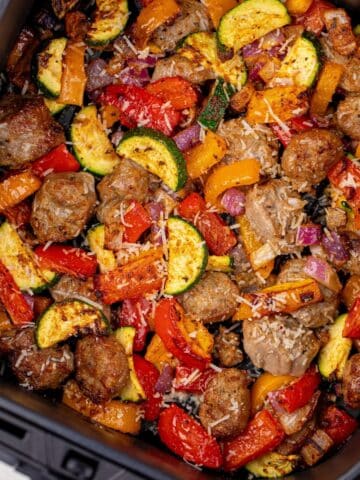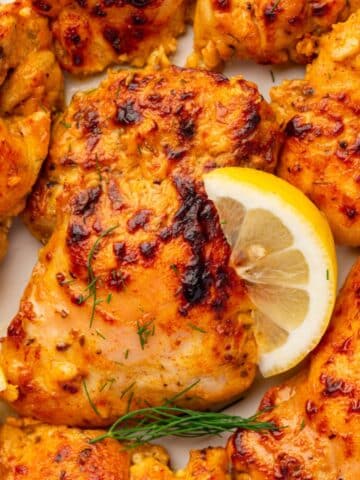This simple, yet flavor-packed recipe for Oven Roasted Whole Chicken is sure to become a family favorite! Featuring tender, juicy meat and deliciously crispy chicken skin.
Considered an essential recipe for the home cook, roasted chicken is the perfect main dish for any occasion. Use the leftovers in your favorite casseroles, and the bones to make broth or soup.

One of our personal favorites is this crispy, juicy, and flavor-packed recipe for roasted chicken. I first learned how to roast chicken in my early 20's, and it has been a frequent (and well loved) addition to my meal plans ever since.
This recipe is the result of many years of trial and error, and learning what really matters (and doesn't matter) when it comes to cooking a basic whole chicken. Trussing? Doesn't really matter. The type of fat you use on the chicken skin? Yes, it really does matter!
I'm sharing my tips and techniques so you can effortlessly make your own oven roasted whole chicken - without the steep learning curve of many other roasting recipes. This is just straight forward, old-fashioned comfort food that you can make in your own home - any day of the week.
Oh, and my son is urging me to tell you all that the skin is the best part! In fact, if you don't watch your family closely, you could end up bringing a skinless chicken to the table!
Why You'll Love It:
- Juicy chicken. Well seasoned and perfectly cooked, this is the best roast chicken recipe, period. Use an inexpensive meat thermometer and you'll get perfectly juicy chicken every time.
- Easier than you think! Because it seems a little fancy, it's easy to get intimidated. You'll be surprised how simple it is, and you'll fall in love with the delicious results.
- You can use the leftover chicken for other meals. One of the best things about roasting a whole chicken is the leftover meat! Use this in your favorite casseroles, soups, or even to make the beloved buffalo chicken dip.
- Budget-friendly. Whole chickens are less expensive per pound than specific cuts, plus their bones can be used to make homemade bone broth!
Ingredients

- Whole chicken: You will need a fresh, whole chicken that is about 3-5 pounds (or 1.3-2.3 kilograms). Remove the giblets (you can use them to make gravy) and pat the skin dry with paper towels.
- Avocado oil (olive oil, or melted butter): I've tested this recipe with avocado oil, olive oil, vegetable oil, AND melted butter. Avocado oil won the taste tests, with the best flavor and crispiest skin - so that's my #1 pick.
- Seasonings: Smoked paprika, garlic powder, onion powder, dried thyme, and black pepper.
- Salt: The recipe uses 1 ½ teaspoons of fine sea salt. This creates a skin that is slightly salty, similar to the rotisserie chickens you would buy at the grocery store. If you like things a little less salty, reduce the salt by up to ½ teaspoon.
- Onion: Peel and quarter an onion, and use it to stuff the cavity of the chicken. This adds flavor, AND holds the shape of the chicken.
- Optional: Garlic cloves, lemon halves (or lemon zest), and fresh herbs added to the cavity can all boost flavor if you happen to have them on hand.
Check the recipe card for a full list of ingredients and the quantities needed.
How to Roast a Whole Chicken

- Add 2 tablespoons of avocado oil (olive oil, or melted butter) to a small bowl, along with the salt and seasonings.
- 1 ½ teaspoons salt
- 1 teaspoon smoked paprika
- ½ teaspoon onion powder
- ½ teaspoon garlic powder
- ½ teaspoon dried thyme
- ½ teaspoon ground black pepper
- Stir the oil and seasonings together until a paste forms.
- Place the chicken in a 9X13" (23 x 33 cm) baking dish lined with parchment paper (for easy clean-up). Remove the giblets, and pat the surface of the skin dry with a paper towel.
- Fill the cavity with a quartered onion, and (if desired) garlic, lemon, herbs, etc.
- Use a pastry brush to brush the seasoned oil on every exposed surface, including the underside of legs, wings, etc.
- Roast in a 425ºF (218ºC) oven for 70-90 minutes, or until each part of the chicken registers at a minimum of 165ºF (74ºC) when tested with a meat thermometer. The time will depend largely on the size of your chicken.
- Dark meat has the best texture at about 170-175ºF, but the temperature will rise after resting.
- Baste with the pan juices 1-2 times during the roasting process. If crispy skin is desired, avoid basting for the final 20-30 minutes of cooking time.
To truss or not to truss? It's totally up to you! I have found in my many years of roasting chicken, trussed chicken can be a bit more tricky to get to temperature, but it does have a nicer presentation and holds its shape better. I like to truss my chicken AFTER roasting if I'm serving it to dinner guests.
Using the Drippings to Make Gravy
You will need at least 1 cup of reserved juices/broth to make a homemade gravy. I find most chickens give off about ½ cup of drippings during cooking, but that can be supplemented with store-bought chicken stock/broth, or even water!
Most importantly, you need to allow the pan drippings to rest in a measuring cup for at least 5-10 minutes so you can spoon off the fat that rises to the top. Otherwise, it makes for a very greasy gravy.
The juices from this recipe in particular are very concentrated and flavorful, so I've found adding water to dilute the flavor and thin the gravy very helpful.
To make homemade gravy:
- Heat a stainless steel saucepan over medium heat.
- Add 1 tablespoon of butter and stir until melted.
- Sprinkle in 1 tablespoon of flour, and stir to form a paste.
- Continue to cook the flour and butter (roux), whisking often, until it turns a light blonde color.
- Pour in 1 cup of reserved pan juices or broth, a little at a time, whisking after each addition.
- Once all of the broth or pan juice is incorporated, bring to a simmer. If desired, add water to thin the gravy to the desired consistency and dilute the flavor.
- Serve with roast chicken, mashed potatoes, etc.
The gravy recipe can be doubled, tripled, etc. based on the amount of liquid you have to work with.

Top Tip: Check Internal Temperature
- The best way to have success with whole roasted chicken (or nearly any meat) is to ensure you're checking the internal temperature with an instant read thermometer (also known as meat thermometer or digital thermometer).
- These are relatively inexpensive, and make a world of difference when it comes to ensuring your meat is cooked to the perfect temperature (165ºF or 74ºC for chicken).
- When testing whole chicken, check all portions of the bird, including the thickest part of the thigh, and the deep into center (just be sure you don't hit bone - which holds a much higher temperature than the meat itself).
- Also, keep in mind that if you let the chicken rest for 5-10 minutes after roasting, you should see an increase in temperature. I like to take it out once the dark meat reaches 165ºF; after a quick rest it should rise to about 175ºF, which is what most folks prefer for dark meat.
Storing Leftovers
Tightly cover leftovers, or transfer to them an airtight container. Store in the refrigerator for up to 3 days, or freeze for up to 3 months (in a freezer bag).
Reheat leftovers in the microwave for the best results, or use them to make casseroles and soups that call for cooked and shredded chicken (like my creamy chicken gnocchi soup).
What to Serve With Roast Chicken
- Mashed potatoes
- Roasted vegetables
- Maple glazed carrots
- Baked potatoes
- Corn on the cob
- Steamed green beans
- Roasted potatoes
- Rice (try my french onion rice)
- Dinner rolls
- Fresh bread and butter

Expert Tips
- Rest at room temperature first. Allowing the chicken to rest at room temperature for about 30-60 minutes before roasting will reduce steam in the oven, resulting in a crispier skin. You can season the chicken at the beginning of the resting time for extra flavor.
- Baste... but not too much. Basting the chicken with the pan juices will help to build flavor and maintain moisture. I recommend doing this 1-2 times during roasting, but going overboard can result in soggy skin.
- Cover the breast meat. If you find that your chicken breasts are cooking more quickly than other parts of the chicken, try covering them with a tent of aluminum foil. This will prevent them from drying out while the rest of the bird cooks.
- Make broth with the bones. Have you ever tried making your own chicken broth? It's easy to do with leftover bones from rotisserie-style chicken. Add a chicken carcass to an Instant Pot, along with some aromatic veggies, peppercorns, and salt. Cover with water and cook for 2 hours at high pressure. Release the pressure, then strain off the bones and vegetables. Use the liquid gold (aka bone broth) in your favorite soups!
What's the Best Way to Get Crispy Skin?
- Avoid excess steam in the oven. Start off by draining the chicken cavity of juices, and patting the skin dry. Then, during the roasting time, remove some of the pan juices as you baste, as it will create steam and soften the skin.
- Use avocado oil. In tests avocado oil performed the best for both flavor and crispy skin. I was actually surprised, as I expected melted butter to come out on top!
- Don't baste during the last 20-30 minutes of roasting. Adding some moisture and fat to the skin can help build flavor and crispiness, but you want to allow ample time for the moisture to evaporate and crisp up the skin.

If you loved this recipe for oven roasted whole chicken, let me know by leaving a 5-star review in the recipe card or comment below! You can also tag me on Instagram @dashfordinner.

Oven Roasted Whole Chicken
Ingredients
- 1 3-5 lb whole chicken giblets removed (about 1.3-2.3 kg)
- 1 medium onion peeled and halved
- 2 tablespoons avocado oil olive oil, or melted butter
- 1 ½ teaspoons salt
- 1 teaspoon smoked paprika
- ½ teaspoon onion powder
- ½ teaspoon dried thyme
- ½ teaspoon garlic powder
- ½ teaspoon ground black pepper
Instructions
- Optional: Allow your chicken to rest at room temperature for 30-60 minutes after removing it from the refrigerator. This will reduce steam in the oven and result in crispier skin.
- Preheat the oven to 425ºF (218ºC) and line a 9X13" (23x33 cm) baking dish or roasting pan with parchment paper (optional).
- Place the whole chicken, breast side up, on the roasting pan. Remove the giblets and pat the skin dry with paper towels.
- Stuff the cavity with the onion halves (optional: add a few garlic cloves and a cut lemon for extra flavor) and set aside.
- Add the avocado oil (olive oil, or melted butter) to a small bowl, along with the salt, smoked paprika, onion powder, thyme, garlic powder, and black pepper. Stir to form a paste.
- Brush the seasoned oil on every exposed surface of the chicken using a pastry brush.
- Roast in the oven for 70-90 minutes, or until all of the pieces register a minimum internal temperature of at least 165ºF (74ºC). Baste 1-2 times during the roasting time if possible. For crispy skin, avoid basting during the last 20 minutes of roasting.
- Remove from the oven and transfer the chicken to a serving platter.
- Allow to rest for 5 minutes before serving.
- If desired, retain the juices for using to make homemade gravy (*see notes).
Notes
make a small amount of gravy. If making just 1 chicken, you can supplement with enough chicken broth (homemade or store-bought) to bring it up to 1 cup of broth/juice. Note that fat should be removed from the juices first. This can be done by transferring them to a measuring cup and spooning off the top layer after 5-10 minutes.
- Make a roux over medium heat with 1 tablespoon of butter and 1 tablespoon of flour.
- Add the juices a little at a time, and stir to combine.
- I like to add a little water to thin the gravy to my liking and to dilute the flavor, since the chicken seasoning blend is strong and bit salty.
Nutrition
Please note that some of my blog posts here at Dash for Dinner may contain affiliate links. If you make a purchase through these links, I will get a small commission at no additional cost to you. Please see my Disclaimer for more information.








Anonymous says
Delicious! Skin was crispy and the meat was really juicy. Loved the gravy too.
kristin garcia says
Do you brine your chicken before roasting?
Dorothy Bigelow says
I don't for this particular recipe, but I definitely do when I'm planning ahead and have the time! It's a great technique to use, and one I plan to share in the future!
Daniel says
I really love this chicken and I really love the crispy skin. This is very good. I love chicken and I hope everyone loves this as much as I do!
From Daniel 🤩